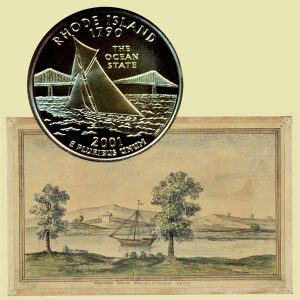Today, the Rhode Island State Quarter Coin remembers when the General Court changed the area’s name to Rhode Island on March 13, 1644.
Through the years, people developed different ideas on the origin of the name of the state.
Let’s look at a few ideas.
From Rhode Island by Irving Berdine Richman, published in 1905:
=====
Rhode Island and Providence Plantations — The Charter of 1663
On March 13, 1644, the General Court of Aquidneck changed the name of that island to the “Isle of Rhodes or Rhode Island.”
No little discussion has from time to time been occasioned by surmises as to the origin of the name; but Roger Williams, writing in 1666, remarked that “Rhode Island, like the Isle of Rhodes, in the Greek language is an island of Roses; ” and derivation more authoritative we perhaps shall not be able to discover.{Note}
At all events, in 1663, when John Clarke was negotiating with the restored monarch Charles II for a royal charter for the Narragansett Bay colony, he was careful to repay Williams for his assumption (in the Patent of 1644) of the name “Providence Plantations” by placing before the latter, in the new instrument, the name “Rhode Island.”
{Note} In the English Historical Review for October, 1903, Mr. Louis Dyer, of Oxford, England, advances the theory that the name “Rhode Island” is merely a translation of the Indian name for the island of Rhode Island — Aquidneck.
“Aquidneck,” observes Mr. Dyer, “the island in the bay, was englished into Road or Roads Island. The prevalence in the early texts of the spelling Road goes to confirm this account of the matter. . . ‘Roade Island is’ (we read in a document dated in 1661 [Richman’s Rhode Island, vol. ii, p. 239]) ‘a road, refuge, asylum, to evil livers.’ ”
From the above Mr. S. S. Rider strongly dissents in Book Notes, vol. xx.
=====
Another viewpoint on the name is found in the President’s address from the Proceedings of the Rhode Island Historical Society published in 1902:
=====
There has been much speculation and discussion about the origin of the name Rhode Island.
It has been supposed to come from a fancied resemblance of the island of Aquidneck to the Isle of Rhodes, on the coast of Asia Minor in the Mediterranean Sea.
There is no apparent reason for coupling in name these two islands, so far apart in situation and so little alike in size and form.
The Isle of Rhodes is three times as long as the island Rhode Island, and more than three times as wide.
It is traversed by a range of mountains over 4,500 feet high.
Mr. Rider, who has made the most exhaustive examination of the subject of any that I know, says in Book Notes, vol. 7, p. 29 (Feb. 15, 1890), that this theory rests simply on a reference made in Hakluyt’s account of Verrazano’s voyage, in 1524, to an island distant from the main land three leagues, ” about the bigness of the Ilande of the Rodes.”
Whatever island this referred to, it could not have been Aquidneck, because the latter was nowhere near the bigness of the Isle of Rhodes, nor was it three leagues distant from the mainland.
On Dutch charts it was called “Roode Eylandt,” i.e., Red Island. But our soil is not so highly colored as to warrant that name.
Arnold, however, adopts this theory (Hist. R. I., vol. I, p. 70), and although he wrote after this letter of Williams was published in the Rhode Island Book, probably he had not seen it, as he does not mention it.
At the General Court of Elections held at Newport, March 13, 1644, this vote was passed: “It is ordered by this Court that the ysland commonly called Aquethneck, shall be from henceforth called the Isle of Rhodes, or RHODE ISLAND.” (R. I. Col. Rec, i; 127.)
In this letter of 1666, Williams says: “Rode Iland (in the Greeke language) is an Ile of Roses, and so the Kings’ Majestie was pleased to resent it.” By the usage of that time the word resent meant receive.
Hence the passage clearly implies that the name of the Isle of Roses was adopted as a derivative from the Greek rodon, rose, or rode, rose tree, and so accepted by the king in the charter of 1663.
This settles the question.
We all remember how vividly Dr. Edward Everett Hale, in his lecture before this society, December 26, 1899, pictured our southern shore in the glory of the rhododendron bloom and, quite apart from this letter of Roger Williams, suggested the Isle of Roses.
=====
The Rhode Island State Quarter Coin shows with an image of Bristol Neck, circa 1765.
